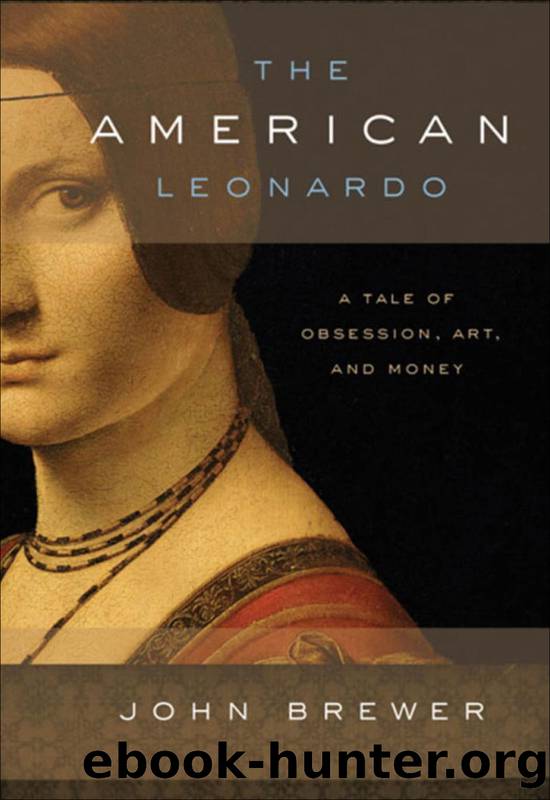The American Leonardo by Brewer John;

Author:Brewer, John;
Language: eng
Format: epub
Publisher: Oxford University Press USA - OSO
Published: 2009-08-15T00:00:00+00:00
SEVEN
THE VIEW FROM KANSAS
Kansas City, on the junction of the Kaw and Missouri rivers and the border between the states of Missouri and Kansas, is an unlikely spot to feature in the history of a supposed painting by Leonardo da Vinci. When Nina Powell, the music and arts correspondent of the Kansas City Star expressed her incredulity at Andrée Hahnâs remarks, made in her office in January 1920, about the presence of a Leonardo in their midst, she was voicing sentiments that would probably have been shared by most inhabitants of the city, at least those who were familiar with the artistâs name. Kansas City, after all, was less known for its culture than for its rough and tumble waysâas one would expect from a city that bore the brunt of violent struggles between Abolitionists and pro-slavers before and during the American Civil War, and which became the trail-head to the Pacific West and, after the erection of the Hannibal rail bridge over the Missouri in 1869, a town with vast stockyards and many railroads. Kansas City stood on the cusp between civilization and the âWild West,â and its disproportionate number of young men and its frontier ways (even after Frederick Jackson Turner had famously declared the frontier closed) made it one of the most wide-open towns in the United States with a nationwide reputation for vice and loose living. As one Midwest newspaper remarked, âIf you want to see some sin, forget about Paris. Go to Kansas City. With the possible exception of such renowned centers as Singapore and Port Said, Kansas City has the greatest sin industry in the world.â
However, the Hahnsâ Leonardo arrived in Kansas City at an opportune moment, one when the cityâs elite, grown rich on the burgeoning industries of âCow Town,â was trying to transform the city and its reputation, clean up its image, and make it a rival of the metropolises in the East. Following in the footsteps of cities that had cleared their slums and built parks, boulevards and upmarket residential neighborhoods, they wanted to refashion their city; a vital part of that program of change was the foundation of cultural institutionsâa university, an orchestra, an opera and, above all, an art gallery and museumâthat would expunge Kansas Cityâs low-life reputation and replace it with one of progressive civility. As Harry Hahn astutely understood, the American Leonardo was extraordinarily enticing to those who wanted to civilize Kansas City; La Belle Ferronnière was tempting because she promised to embody and exemplify the changing character of a town, to broadcast to the nation that Kansas City was not just an ugly industrial center with a reputation for squalor and depravity, but a leader in the march toward a more refined way of American living.
The early twentieth century saw Kansas City grow by leaps and bounds, nearly doubling in size between 1910 and 1930. Down by the river on the floodplain of the Kansas River, known as the West Bottoms, stockyards, slaughterhouses, meatpacking houses, smelting
Download
This site does not store any files on its server. We only index and link to content provided by other sites. Please contact the content providers to delete copyright contents if any and email us, we'll remove relevant links or contents immediately.
Technical Art History by Jehane Ragai(456)
Art, Science, and the Natural World in the Ancient Mediterranean, 300 BC to AD 100 by JOSHUA J. THOMAS(410)
Graphic Culture by Lerner Jillian;(397)
The Slavic Myths by Noah Charney(370)
Pollak's Arm by Hans von Trotha(340)
Simply Artificial Intelligence by Dorling Kindersley(339)
Treasuring the Gaze by Hanneke Grootenboer(337)
Sketchbook Confidential: Secrets from the private sketches of over 40 master artists by Editors of North Light Books(337)
The Art of Portrait Drawing by Cuong i(331)
Drawing for the Soul by Zoë Ingram(328)
Drawing Landscapes by Barrington Barber(320)
Mountain Manâs Field Guide to Grammar by Gary Spina(313)
The Art of Painting Sea Life in Watercolor by Maury Aaseng Hailey E. Herrera Louise De Masi and Ronald Pratt(310)
Portrait of a Woman by Bridget Quinn(300)
Anatomy for the Artist by Jennifer Crouch(293)
A text-book of the history of painting by Van Dyke John Charles 1856-1932(288)
Preparing Dinosaurs by Wylie Caitlin Donahue;(282)
Botanical Illustration by Valerie Price(280)
Egyptian art by Jean Capart(277)
